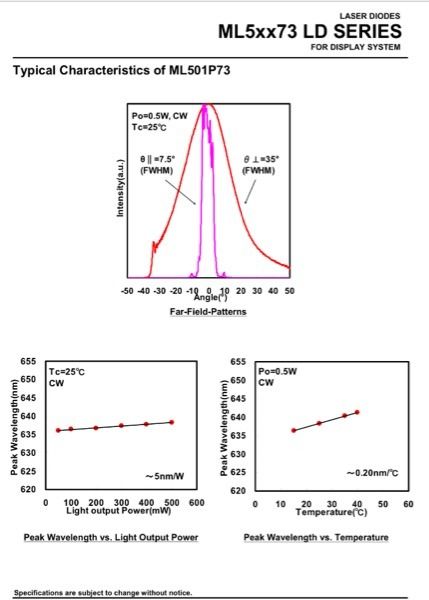- Joined
- Aug 16, 2013
- Messages
- 966
- Points
- 43
Hey folks,
Help me wrap my mind around something.
When we talk about wavelength shift the first thing that comes to mind is the gain we achieve with the 462s. My Ndb7576 spectro'd at a whopping 471nm @ 2.6A! Greater amperage equals increase wavelength and apparent brightness.
Now, how does this apply to reds I.e. 638s and 650s?
Take the mitts 500mW. If you drive it at the data sheets recommend 650mA you get 638.
If we over drive these diodes to say 1A. Which way does the wavelength shift? Greater than 638? Maybe 641? These are arbitrary numbers I don't have a spectrometer. A shift higher here would appear darker in color to the human eye but brighter in apparent power.
So what's the point here? If you wanted to achieve a more orange color you would under drive these diodes and sacrifice power.
This idea is inverse from blues because we are on the opposite side of 555nm. The peak of visible acuity.
Here is a chart from the data sheet. If the current and temperature to the diode is decreased the WL will shift lower. Even if a few nm is not noticeable to the human eye.

Does this make sense or is it just too early in the morning for me to process? :tired:
This is a precursor to an experiment I might do this summer on red shift.
Help me wrap my mind around something.
When we talk about wavelength shift the first thing that comes to mind is the gain we achieve with the 462s. My Ndb7576 spectro'd at a whopping 471nm @ 2.6A! Greater amperage equals increase wavelength and apparent brightness.
Now, how does this apply to reds I.e. 638s and 650s?
Take the mitts 500mW. If you drive it at the data sheets recommend 650mA you get 638.
If we over drive these diodes to say 1A. Which way does the wavelength shift? Greater than 638? Maybe 641? These are arbitrary numbers I don't have a spectrometer. A shift higher here would appear darker in color to the human eye but brighter in apparent power.
So what's the point here? If you wanted to achieve a more orange color you would under drive these diodes and sacrifice power.
This idea is inverse from blues because we are on the opposite side of 555nm. The peak of visible acuity.
Here is a chart from the data sheet. If the current and temperature to the diode is decreased the WL will shift lower. Even if a few nm is not noticeable to the human eye.

Does this make sense or is it just too early in the morning for me to process? :tired:
This is a precursor to an experiment I might do this summer on red shift.
Last edited:





